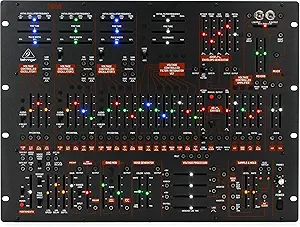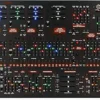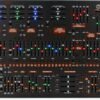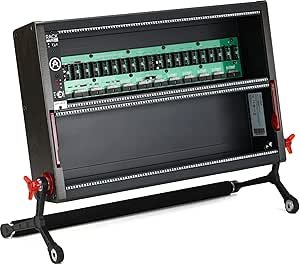Behringer 2600 Analog Synthesizer Review Unveiling Features and Sound Quality
Behringer 2600 Analog Synthesizer Review Unveiling Features and Sound Quality
- Rich analog sound quality that rivals more expensive synthesizers, delivering warmth and depth in every note.
- The build feels sturdy and durable, ensuring long-term use without concerns about wear.
- The spring reverb emulation adds unique character, creating an immersive sonic experience.
- Highly versatile with extensive patch points, offering endless creative opportunities for sound design.
- Compact and rack-mountable design, making it a space-saving addition to any studio setup.
As an Amazon Associate I earn from qualifying purchases.
Description
Immersing Myself in the World of the Behringer 2600 Analog Semi-modular Synthesizer
Testing out the Behringer 2600 Analog Semi-modular Synthesizer was like stepping into a time machine that transported me directly to the golden days of analog synthesis. This semi-modular synthesizer is a re-creation of the legendary 2600, and let me tell you, the nostalgia is almost palpable. It’s not just about the vintage vibes, though; this synth offers a modern twist with its impressive array of features.
From its three robust VCOs to its multimode VCF, this unit packs a punch for anyone looking to explore the depths of sound design. I found myself spending hours tweaking its 78 faders and switches and experimenting with its 93 patch points. Whether you’re a modular aficionado or just someone dipping their toes into synthesis, this product offers a creative playground like no other.
Design That Demands Attention
The design of the Behringer 2600 is pure eye candy for any synth enthusiast. Its multicolor panel isn’t just visually striking; it’s also practical. I appreciated how the color-coded sections made it easier to navigate the maze of controls. Despite its larger dimensions of 17.85 x 7.85 x 24.75 inches, it fits well into a studio setup, especially with its rackmount compatibility.
Handling the unit, I noticed the basswood construction felt sturdy, adding to its overall durability. At 15.21 pounds, it’s a bit hefty, but that weight contributes to its solid, professional feel. The 3.5mm TS jack connectors are industry-standard and reliable, ensuring seamless integration with other gear. This design is clearly built with both functionality and aesthetics in mind.
The Sound: A Universe of Possibilities
Diving into the sound capabilities of this synthesizer was an absolute treat. The three oscillators provide a thick and rich tone. I found that layering them created some truly massive sounds, perfect for both classic and modern electronic music. The multimode filter added another layer of versatility, allowing me to sculpt sounds with precision.
The digital spring reverb emulation deserves a special mention. While it’s not a true spring reverb, the emulation is surprisingly convincing. It added a vintage character to my patches, which I absolutely loved. The two envelope generators were responsive, making it easy to create everything from punchy basslines to evolving pads. This synth is a sound designer’s dream.
Key Benefits
- Authenticity: Faithful re-creation of a classic analog synthesizer.
- Massive Modulation Options: Includes 93 patch points for endless routing possibilities.
- Multi-Oscillator Setup: Three oscillators for thick, layered sounds.
- Durability: Built with a sturdy basswood body.
- Intuitive Design: Color-coded sections and 78 faders and switches for easy navigation.
Downsides to Consider
While I was thoroughly impressed with this semi-modular synth, there were a few areas where it fell short.
- Learning Curve: The sheer number of controls can overwhelm beginners.
- Size and Weight: At 15.21 pounds, it’s not the most portable option.
- Digital Reverb: While good, it doesn’t quite match the organic feel of true analog spring reverb.
- Patch Cable Chaos: The 93 patch points can get messy quickly, especially for those new to modular setups.
Product Contenders: Standing Out in a Competitive Market
In testing, I couldn’t help but compare the Behringer 2600 to other products in the same category. The Korg ARP 2600 FS immediately came to mind. While the Korg unit is undeniably iconic and offers exceptional build quality, it also comes with a significantly higher price tag. In terms of sound, the Behringer version holds its own quite well, delivering a similarly rich analog texture.
Another popular alternative is the Moog Grandmother. The Moog excels in terms of warmth and simplicity, but it lacks the deep patching options that the Behringer 2600 provides. For those who want to dive into modular setups, the Behringer model is undoubtedly the better choice. However, if portability is your main concern, the Moog Grandmother is more compact and lightweight.
Worth Every Penny: A Look at Cost Efficiency
Evaluating the value proposition of the Behringer 2600, I’d say it’s hard to beat. While it doesn’t have the pedigree of some of its competitors, it delivers incredible functionality at a fraction of the cost. The inclusion of Eurorack compatibility adds even more bang for your buck, allowing seamless integration into a modular setup.
Is it perfect? Not quite. But for the price, you’re getting a powerhouse of a synth that’s capable of producing everything from retro-futuristic bleeps to complex, evolving soundscapes. For anyone interested in dipping their toes into the world of analog synthesis or expanding their existing setup, this product is a no-brainer investment.
Additional information
| Body Material | Bass Wood |
|---|---|
| Connector Type | 3.5mm TS jack |
| Manufacturer | Behringer |
| UPC | 644216634507 |
| Item Weight | 15.21 pounds |
| Product Dimensions | 17.85 x 7.85 x 24.75 inches |
| Item model number | 2600 |
| Color Name | Multicolor |




